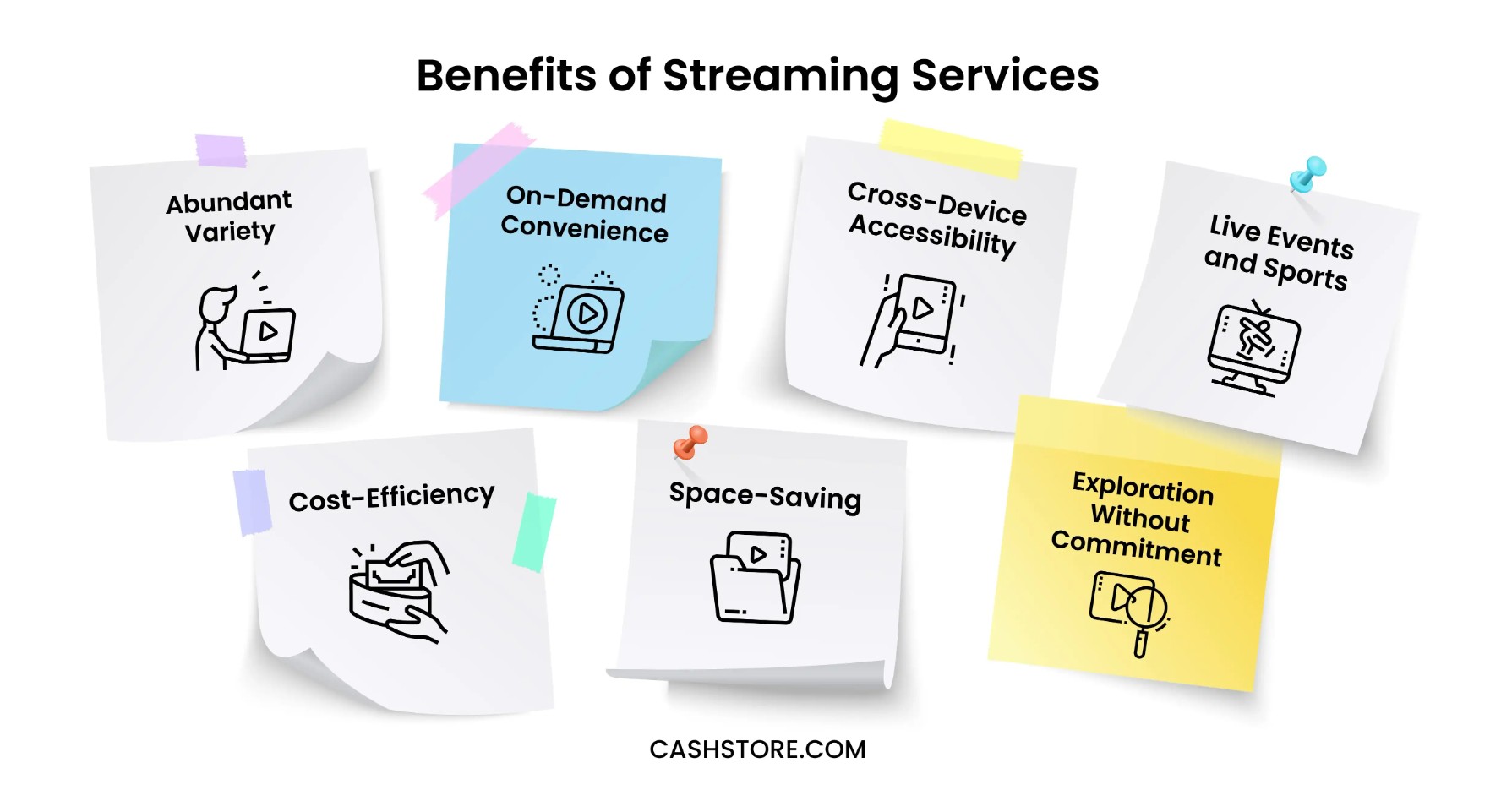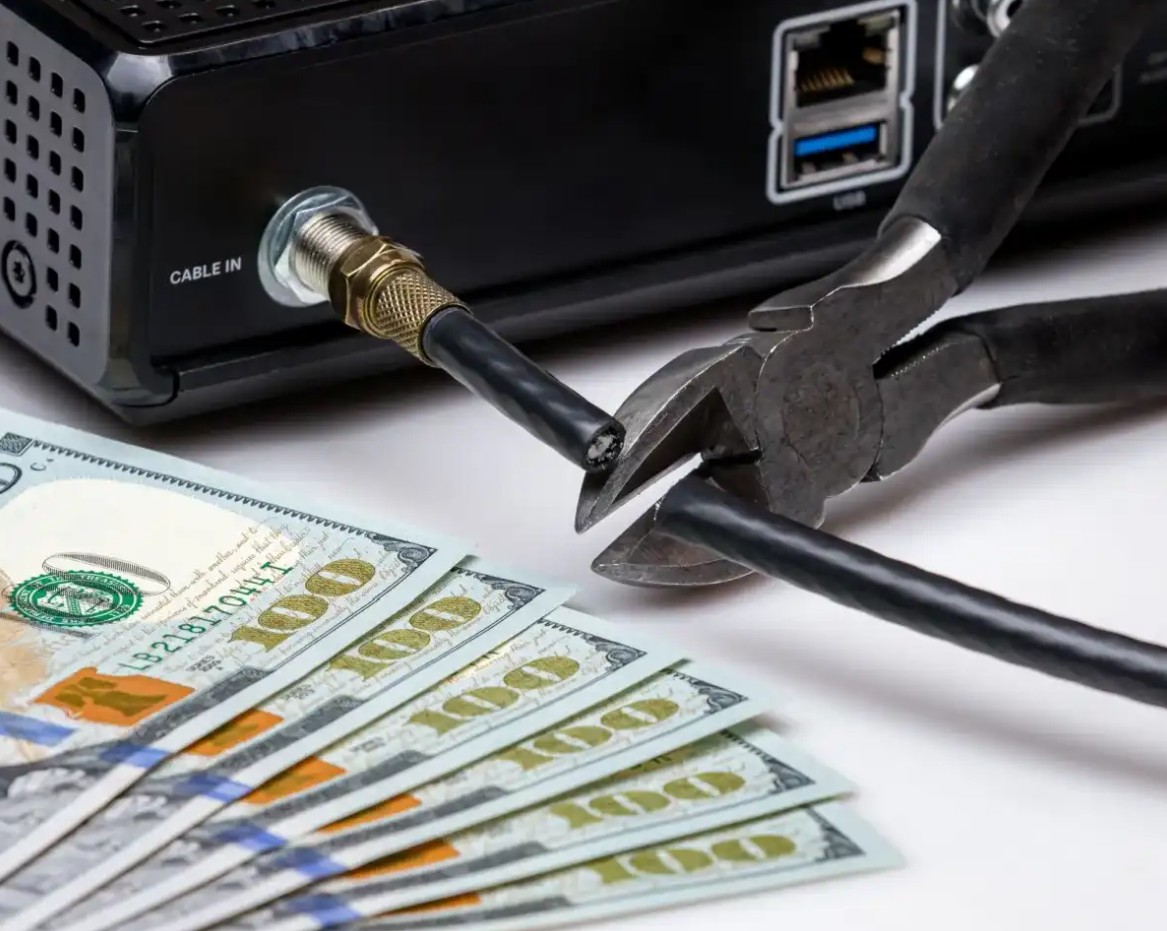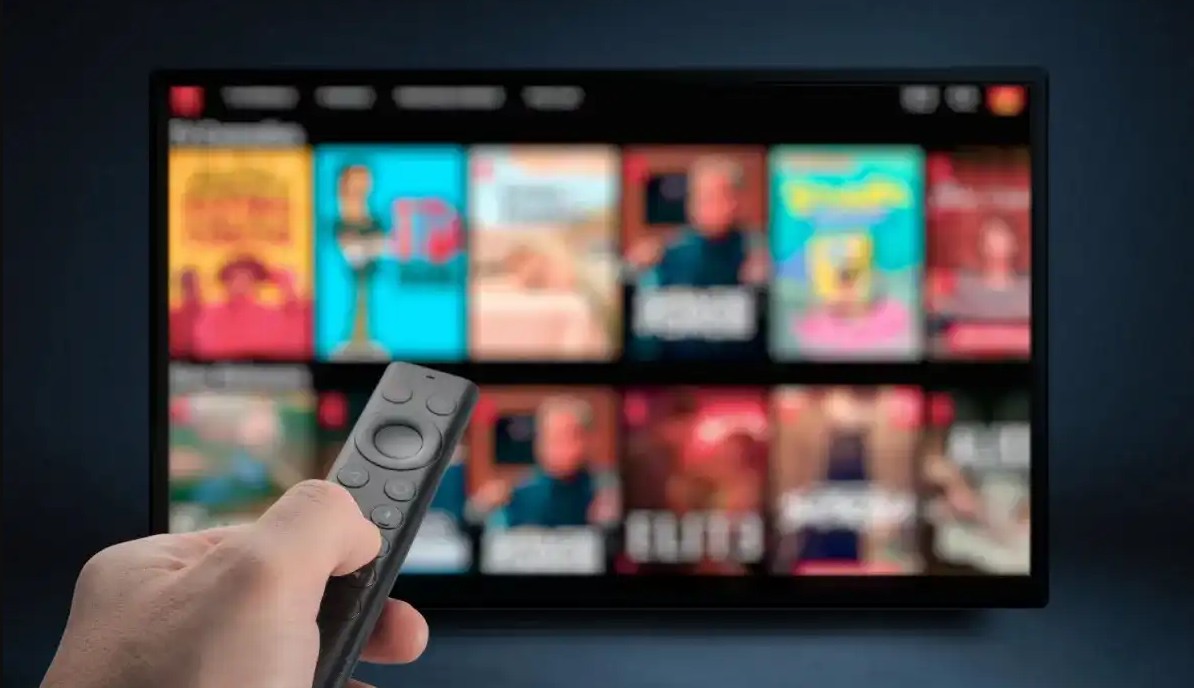Cash Store Blog
The Real Costs of Streaming Subscriptions: Can You Still Save by Cutting the Cord?
In a world where the way we watch TV is rapidly changing, the numbers don't lie: traditional cable TV is losing its grip on our screens. According to the latest data from Nielsen, in July 2023, linear TV viewership dropped below 50% for the first time ever. Broadcast TV hit a new low of 20%, while cable TV followed closely behind at 29.6% of total TV usage, combining for a linear television total of 49.6%.
Meanwhile, streaming services are on the rise. Time spent streaming via television increased by 2.9% in July compared to June, reaching a record high of 38.7% of total TV usage. The big players in the streaming game, like YouTube, Netflix, and Amazon Prime Video, saw significant month-over-month increases in viewership, with growth percentages ranging from 4.2% to 5.6%.
In this article, we'll explore the financial impact and practicality of switching from cable TV to streaming services. We'll explore the potential savings, drawbacks, and crucial considerations to help you make an informed decision about cutting the cord on traditional cable TV. So, let's get started!

The Evolution of Television Consumption and Why Today’s Viewers are Cutting the Cord
Cord-cutting, as it's popularly known, has sent shockwaves through the TV industry, with cable TV providers struggling to retain their once-loyal customers. In fact, between 2019 and 2022, traditional pay-TV providers lost approximately 6 million subscribers each year. The trend shows no signs of slowing down, as the first quarter of 2023 witnessed another 2.3 million customers bidding farewell to cable TV.
But here's the twist: most cord-cutters aren't bidding adieu to live TV entirely. Instead, they're migrating to all-digital live TV streaming services like Sling TV, YouTube TV, fuboTV, and Hulu + Live TV. This shift allows viewers to enjoy the best of both worlds – live programming and on-demand content, all at their fingertips.
The allure of streaming subscriptions continues to grow. Between September and December 2022, the number of households embracing video streaming surged by 2.5 million, reaching a staggering 115.6 million households. This means that video streaming now penetrates 89% of American households. And it doesn't stop there; households are increasingly stacking their subscriptions, with the average home accessing 5.4 different streaming services, up from 5.2 in the third quarter of 2022.
In 2023, a whopping 83% of consumers in the U.S. were using a subscription video-on-demand service, marking a remarkable increase of over 10 percentage points in just five years. The tides have shifted, and streaming is now firmly in the spotlight as the preferred choice for modern TV viewers. But what does this mean for your wallet?
The Cost of Cable TV: Unpacking Your Monthly Bill
Before we embark on the cord-cutting journey and dive into the world of streaming services, it's crucial to take a look at an overlooked aspect of traditional cable TV: the monthly bill. Understanding the components of your cable bill and how they stack up against the expenses of streaming services is essential in making an informed decision.
Understanding Cable Costs
The cost of traditional cable TV has long been a concern for consumers. Recent data compiled from various public sources reveals that the average monthly cable package now stands at a staggering $217.42 per month. To put this into perspective, it's more than the average monthly expenditure on all other major utilities combined, which totals around $205.50. However, what makes deciphering cable bills even more challenging is that they often include hidden costs that can inflate your monthly expenses.
Cable companies typically advertise one price for their services but can tack on additional charges, such as broadcast fees, cable box rentals, or other miscellaneous costs that easily add $50 or more to your monthly bill. Moreover, they employ bundling strategies that make it difficult to discern how much you're actually paying for cable television.
A typical cable TV bill comprises several components:
- Programming: This includes the cost of your chosen cable package and any channel add-ons.
- Equipment: Cable box rentals and additional devices come at an extra cost.
- Fees: You'll encounter various fees, such as broadcast fees and regulatory fees, which can vary by location.
Over the past decade, cable prices have seen a significant increase, soaring by $133.38 per month. While yearly price hikes have ranged from as low as $6 or $7, some years witnessed spikes close to $24, as was the case between 2016 and 2017. This cost isn't just about the content you watch; it also encompasses the network infrastructure, maintenance, labor, and adapting to evolving technology.
If you bundle cable with internet services, the cost can fluctuate based on channel counts, internet speeds, and any additional equipment or services. Cable providers face pressures from licensing TV content and other factors, which can lead to price increases, even when your channel lineup remains relatively unchanged. As long as there's a demand for TV, we can expect cable prices to continue their upward trajectory.

Comparing Cable Costs with Streaming
As we've seen, cable TV costs continue to soar, leaving many viewers searching for alternatives. It's no wonder that nearly one-third of global consumers are planning to cut back on their streaming subscriptions, according to YouGov, a consumer research firm. In the U.S, consumers are already spending an average of approximately $54 per month on streaming services, as reported in a 2022 survey by J.D. Power, a data analytics company.
Streaming platforms offer a lifeline for those looking to escape the escalating costs of traditional cable. One cost-effective alternative to consider is Netflix. With over 238.39 million paid subscribers worldwide as of the second quarter ofQ2 2023, Netflix has solidified its position as a leading subscription-based streaming service. In the previous year, Netflix produced a staggering 891 original productions, resulting in an impressive $31.61 billion in revenue and $4.49 billion in net income.
Not only does Netflix provide a vast library of content at a fraction of the cost of cable TV, but it also boasts an extensive catalog of original programming, giving viewers more options than ever before. Let's delve deeper into how these streaming services can offer both savings and variety in your entertainment choices.
The Streaming Revolution: Variety, Flexibility, and Accessibility
A projected 80 million U.S. households plan to make the leap and cut the cord by 2026. At the heart of this revolution are cost-saving benefits and unmatched flexibility. Streaming services have ushered in an era of entertainment accessibility, offering viewers a diverse array of content, all at their fingertips.
Benefits of Streaming
Streaming services have reshaped the way we consume entertainment, offering a treasure trove of advantages that traditional cable TV can't match:
- Abundant Variety: From the juggernauts like Amazon Prime Video, Hulu, Netflix, and Roku to Sling TV, YouTube TV, and Disney+, streaming platforms provide a vast array of captivating, original content alongside beloved classics.
- On-Demand Convenience: With streaming, you call the shots. Watch what you want, when you want, and where you want. No more rigid schedules or missed episodes.
- Cross-Device Accessibility: Enjoy seamless viewing across Android or Apple devices, smart TVs, gaming consoles, and more. Your entertainment follows you.
- Live Events and Sports: Don't miss out on live streaming events, from NFL games to college basketball and other sports. Many streaming platforms offer live TV options for sports enthusiasts.
- Cost-Efficiency: Some streaming platforms are entirely free, eliminating the need for pricey cable subscriptions.
- Space-Saving: Streaming content takes up minimal storage space compared to downloading, preserving your device's memory.
- Exploration Without Commitment: Dive into new shows with no strings attached. Explore fresh genres and discover hidden gems without long-term commitments.
Streaming services bring entertainment to on your terms, offering a treasure chest of shows, movies, and music accessible anytime, anywhere, and on the device of your choice.
Flexibility in Streaming Plans
One of the standout features of streaming services is the flexibility they offer in subscription plans. Unlike traditional cable, where you're locked into fixed packages, streaming platforms empower you to tailor your viewing experience to suit your preferences and budget.
- Customizable Subscription Plans: Streaming services understand that one size doesn't fit all. They often provide a range of subscription tiers, allowing you to choose the plan that aligns with your needs. Whether you want basic access or a premium experience, there's a plan for you.
- Ad-Free Content: Many streaming platforms offer the option to go ad-free, giving you uninterrupted viewing pleasure. Say goodbye to annoying commercial breaks and enjoy your favorite shows seamlessly.
- Tailored Content Consumption: Streaming services leverage sophisticated algorithms to recommend content based on your viewing history. This personalization ensures that you discover new shows and movies aligned with your interests.
With streaming, you're in the driver's seat, crafting an entertainment experience that suits your lifestyle. It's a level of flexibility and customization that cable TV can't match, making the switch even more appealing.

Do Streaming Subscriptions Really Save Money? A Breakdown
As the streaming revolution continues to gain momentum, one burning question remains: does cutting the cord on cable TV truly save you money? We're about to unravel the financial implications of this pivotal decision. From subscription costs to hidden fees and the value of bundled services, we'll dissect the numbers and lay out the facts to help you determine if streaming subscriptions are a wallet-friendly choice.
Assessing Streaming Costs
The streaming landscape is as diverse as it is expansive, with a plethora of services catering to every taste and preference. To make an informed decision about cord-cutting, it's essential to understand the various types of streaming services available:
- The Big Dogs: These giants include Amazon Prime, Apple TV+, Disney+, Hulu, and Netflix, offering a vast library of content.
- British Fare: Services like Acorn and BritBox specialize in British TV shows and films.
- Cable Replacement Services: Hulu + Live TV, YouTube TV, and others mimic traditional cable packages, providing live TV and on-demand content.
- Free Services: Pluto TV, The Roku Channel, Tubi, ViX, WBTV, Xumo Play, and others offer free ad-supported content.
- Network Services: ESPN+, Paramount+, Peacock, and others focus on specific networks' content.
- Niche Services: Criterion Channel and PBS Passport cater to specialized tastes.
- Premium Channels: Max (formerly HBO Max), Showtime, and Starz feature premium content.
Now, let's break down the costs of some popular streaming services:
- Netflix: Basic with Ads for $7 per month, Basic for $10, Standard for $15.50, and Premium for $20.
- Disney+: Disney+ (With Ads) for the price of $7.99/month. Disney+ (No Ads) for the price of $10.99/month or $109.99/year.
- Hulu: Ad-supported plan costs just $7.99/month
- Hulu + Live TV: Hulu + Live TV (With Ads) now includes Unlimited DVR at no additional cost for $69.99/month.
- YouTube TV: Priced at $72.99 per month.
- Amazon Prime: Bundled with Prime membership at $14.99 per month.
- Acorn TV: Available at $6.99 per month.
- Pluto TV: Completely free with ads.
- Criterion Channel: Priced at $10.99 per month.
With the myriad of choices available, it's easy to accumulate multiple subscriptions. It's vital to consider the cumulative monthly expense of these services to determine if the cost remains favorable compared to traditional cable TV.
Comparing Costs with Cable
Let's look at the numbers: the average cost of cable TV, which averages about $217 per month when factoring in hidden fees and bundled packages, doesn't always offer the best bang for your buck. Add the average cost of internet service ($67), and you'd be shelling out around $282 monthly for TV and internet combined.
Now, consider streaming services like Netflix with ads and Disney Plus with ads, which offer more cost-effective options. These platforms can provide a diverse range of content, often for less than half the price of a traditional cable package. In fact, you could save $100 or more per month by making the switch to streaming, all while enjoying the flexibility to tailor your subscriptions to your liking. It's a budget-friendly move that doesn't compromise on content choices.
Content Considerations: Balancing Cost with Desired Viewing
In today's ever-evolving media landscape, content diversity and instant gratification are vital. Viewers seek a balance between cost-effective streaming options and satisfying their specific entertainment cravings. With 45% of consumers indicating they're willing to switch brands if their needs aren't anticipated, understanding how to meet those demands is essential.
Let's explore how streaming services are adapting to fulfill viewers' desires while keeping costs in check.
Content Diversity on Streaming Platforms
Streaming services have become a haven of diverse content, offering something for every viewer. From drama and comedy to documentaries, sci-fi, and niche genres, the range of choices is astounding. What sets streaming apart is its emphasis on original programming and exclusive shows. Netflix, Amazon, and Apple, among others, are investing significantly in original content, recognizing its power to drive subscriptions.
While price, delivery method, and technology play crucial roles, original content remains a cornerstone. It's not the sole driver but a compelling factor. Research from Harvard Business Review suggests that a combination of the right price, sought-after shows, and original content as an added perk can significantly influence viewers' decisions to cut the cord. In a world of endless choices, streaming services are thriving by catering to the evolving tastes and preferences of today's demanding consumers.
Addressing Content Gaps
While streaming platforms offer a diverse range of content, there are limitations and potential gaps that viewers may encounter. One notable content gap is in the realm of sports. Netflix, for instance, has chosen not to dive into the sports content arena, largely due to the high costs associated with sports broadcasting. Instead, they focus on maximizing engagement per dollar spent on content.
Sports can indeed attract significant audiences, but many Netflix series generate even larger numbers in terms of engagement. Some Netflix series can amass over 100 million hours of viewership in a single week. While sports content can be an effective subscriber magnet, it also often leads to demands for additional channels and services.
Supplementary solutions, such as subscribing to dedicated sports streaming services or exploring cable alternatives that offer sports packages, can help bridge the sports content gap for enthusiasts. For now, Netflix's commitment to serving its massive audience without sports content remains a strategic choice.
Potential Drawbacks of Cutting the Cord: Connectivity and Experience
While the cord-cutting trend has undeniable advantages, it's not without its challenges. Two significant factors that can impact your streaming experience are internet connectivity and device compatibility.
Dependence on Internet Connectivity
Streaming services heavily rely on stable internet connections for uninterrupted viewing pleasure. A good benchmark for smooth streaming is a download speed of at least 100Mbps and an upload speed of at least 10Mbps. With 100Mbps, you can comfortably stream Netflix or YouTube, participate in Zoom meetings, and engage in online gaming on multiple devices simultaneously.
However, internet needs vary. Some can manage with lower Mbps, while others may require more. To find the perfect fit, consider personalized recommendations based on your usage or utilize a speed test. For those who regularly use popular apps like Netflix and Zoom, it's advisable to have at least 25Mbps download speeds.
In cases of shared Wi-Fi usage or multiple devices connected, upgrading to faster speeds can prevent slowdowns and buffering.
In areas with poor coverage, streaming can be challenging but not impossible. You can improve your streaming experience by using alternatives like ethernet cable runs for a direct and stable connection. Network bonding combines multiple internet connections to boost speed and reliability. Mobile hotspots can provide a reliable connection if your cellular signal is strong. For critical events or remote locations, satellite trucks can offer a dependable internet connection.
User Experience and Device Compatibility
User experience and device compatibility are key considerations when it comes to a successful streaming experience. While many embrace the convenience, older viewers, less familiar with streaming, may encounter challenges.
Nevertheless, a significant 79% of adults aged 50 and over are using streaming services, with a growing preference for ad-supported options. In fact, 65% of older streamers prefer advertising-based video on demand (AVOD).
This said, regardless of experience, streaming is accessible on a variety of devices, including:
- Smart TVs
- Non-smart TVs with streaming devices (e.g., Amazon Firestick or Chromecast)
- Computers or laptops
- Tablets
- Smartphones
- Video gaming consoles
With diverse options and a broadening user base, streaming is evolving to accommodate various preferences and levels of tech-savviness.
Making an Informed Decision: Evaluating Your Viewing Habits
Understanding your viewing habits is pivotal in deciding whether to cut the cord and embrace streaming. In 2023, U.S. adults are expected to spend nearly three hours daily watching TV, with a recent trend of declining viewership.
The exception was 2020, when media consumption surged during the pandemic. Let's explore how your viewing patterns can guide your decision-making process in this ever-evolving landscape of entertainment consumption.
Assessing Viewing Habits
To make an informed decision about cord-cutting, it's crucial to evaluate your television consumption patterns. While the average U.S. adult spends nearly three hours daily watching TV, your habits may vary. Age and personal interests play a significant role; for instance, adults aged 65 and above often exceed four hours of daily TV time, while younger viewers may clock in less than two hours.
Consider which channels and content are essential to your viewing experience. Reflecting on your unique habits and preferences will guide you in selecting the most suitable streaming options to match your entertainment needs while optimizing your budget.
Calculating Potential Savings
Switching to streaming can be a savvy financial move, and calculating your potential savings is a key step in the process. Here's a step-by-step guide to help you determine the impact on your family budget:
- Determine Your Current Cable Costs: As we've mentioned, the average monthly cable package now stands at $217.42 per month. Note this figure for reference.
- List Your Preferred Streaming Services: Identify the streaming platforms that align with your content preferences. Netflix, Disney+, Hulu, YouTube TV, Amazon Prime, Acorn TV, Pluto TV, and Criterion Channel are among your options.
- Sum the Costs: Add up the monthly subscription costs of the streaming services you plan to subscribe to. For example:
- Netflix (Basic with Ads): $7
- Disney+ (With Ads): $7.99
- Hulu (Ad-supported): $7.99
- YouTube TV: $72.99
- Amazon Prime (Bundled with Prime membership): $14.99
- Acorn TV: $6.99
- Pluto TV: Free with ads
- Criterion Channel: $10.99
- Compare to Cable Costs: Compare the total cost of your selected streaming services to your previous cable expenses. You'll likely find substantial savings by choosing cable TV alternatives.
Remember, streaming offers not only financial benefits but also the flexibility to customize your content lineup according to your preferences, making it a compelling choice for the budget-conscious viewer.
Conclusion: Navigating the Cord-Cutting Landscape
As you contemplate the decision of cutting the cord, it's essential to weigh the pros and cons thoughtfully. Throughout this journey of exploring streaming vs. cable TV, we've uncovered the benefits of streaming services, such as flexibility, customization, and cost-efficiency. However, transitioning to cable TV alternatives with streaming services comes with its own set of considerations.
First and foremost, remember the financial aspect. The costs of cable TV alternatives through streaming services can be significantly lower, especially when compared to the staggering average monthly cable bill of $217.42. This shift can empower you to manage your personal finances more effectively, putting money back in your pocket.
Yet, the decision isn't solely about finances. It's about your unique viewing habits and preferences. Streaming services offer a wide array of content, catering to various tastes, but it's vital to assess which channels and shows are indispensable to you. Moreover, internet connectivity and device compatibility play crucial roles in ensuring a seamless streaming experience.
In conclusion, cutting the cord is a decision that demands thoughtful consideration. The streaming revolution offers an enticing landscape of opportunities, but it's essential to tailor your choices to your personal needs and budget. By carefully evaluating your viewing habits and exploring the ever-expanding world of streaming services, you can embark on a cord-cutting journey that enhances your entertainment while optimizing your financial wellness.


